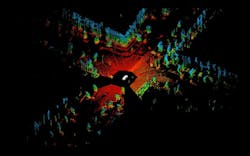This article is part of the TechXchange: LIDAR Technology
To move our society closer to the reality of fully autonomous vehicles taking over the roadways, a number of different solutions are being tested. One of these solutions is LiDAR (Light Detection and Ranging), which utilizes lasers to calculate the distance between itself and other objects. With all the buzz around autonomous vehicles and a wide range of options in the market, it can be difficult to fully understand the capabilities of LiDAR and separate fact from fiction. What follows are 11 myths that have emerged regarding LiDAR solutions.
1. LiDAR is a very high-tech solution.
LiDAR was invented shortly after the invention of pulsed laser, which releases repetitive pulses of light instead of a continuous wave, in the early 1960s. The principle of LiDAR is actually very simple. Like bats that use sound waves during echolocation to register when the waves bounce back from objects in order to measure distances, LiDAR utilizes light waves from a laser to perform this function. LiDAR sends a pulse and measures the time it takes to reflect back from objects. Since the speed of light is constant, distance can be readily calculated by measuring the time it takes for the beam to return. This fundamental working principle hasn’t changed in the past half-century; thus, the working principle has remained rather straightforward when developing LiDAR technology.
2. LiDAR is expensive.
While this was true for a very long time, mostly due to the fact that laser sources were expensive, the invention of the laser diode dramatically lowered the cost of LiDAR. Today, a visible pulsed laser diode can be obtained for less than $1, accounting for a very small fraction of the total cost to build a LiDAR. Imaging LiDAR allows for more than a single point to be measured, and the high cost of building these systems is typically associated with the manufacturing method. By adopting innovative methods to make these systems, for instance, Cepton’s Micron Motion Technology (MMT) platform, imaging LiDAR can be manufactured at a cost of no more than a couple hundred dollars.
Cepton’s automotive LiDAR point cloud 360-degree surround view.
3. Solid-state LiDAR is the best approach because it has no moving parts.
Solid-state LiDAR with no moving parts only improves the reliability of the LiDAR system’s construction. This is because a solid-state LiDAR structure is free of wear and tear that would be caused by rotating or frictional parts. However, this advantage means that some performance sacrifices will have to be made, including a reduction in measurement range, smaller field of view, and more susceptibility to ambient light sources like sunlight. In addition, the high cost associated with manufacturing solid-state LiDAR prohibits it from being massively deployed for the consumer market in the near future.
4. Flash LiDAR is the best LiDAR for imaging.
NASA uses flash LiDAR for its space-station docking operations because it enables high resolution and long-distance imaging to see across distances in space. Unfortunately, this system is far too expensive for integration into fleets of autonomous vehicles—it can cost well over one million dollars per unit due to the high cost associated with the components used for 1550-nm wavelength. It also is very power intensive, consuming up to 100 kW of power. While the imaging performance of flash LiDAR is the best available on the market, there will be no everyday automobile that could adopt such an expensive system.
5. LiDAR must operate infrared wavelengths.
LiDAR can operate at any wavelength as long as a short pulse is able to be generated. In fact, a number of survey LiDAR systems work with visible green lasers. For automobile applications, any visible laser would be a significant distraction to nearby traffic. As a result, infrared wavelengths are usually chosen since they’re not visible to the human eye.
6. LiDAR isn’t safe for the human eye.
Eye safety is a complex combination of factors that aren’t just based on the wavelength of a laser. The safety rating of a LiDAR depends on the power, divergence angle, pulse duration, exposure direction, as well as the wavelength. Under these conditions, a 1550-nm laser can safely emit more power than a 905-nm laser before it becomes non-eye safe. Meanwhile, 905-nm lasers are more popular since they’re more cost-efficient. To help make these 905-nm lasers eye safe, engineers have devised sensitive optical detectors that don’t require the use of high-power lasers.
7. LiDAR can’t work in poor weather conditions.
LiDAR is an optical device just like a camera, so if fog is heavy enough to block all light transmission, LiDAR could become less effective. However, LiDAR will still provide valuable data in typical road conditions. Self-driving cars of the future will integrate a mix of cameras, radar systems, and LiDAR to balance out the advantages and disadvantages of each solution—no one system is perfect—to keep passengers safe in a variety of different weather conditions.
8. LiDAR can only be used for automobiles.
Utilizing LiDAR for automobile applications is a relatively new trend. When it was first invented, LiDAR was most notably utilized for measuring the distance between the earth and the moon; it was also often used to measure weather systems. Today, LiDAR can be employed for any application that requires distance information of an object.
In addition to self-driving cars, LiDAR is ideal for numerous transportation solutions, including trains, shuttles, and trucks. LiDAR is also being used with unmanned aerial vehicles (UAVs) for a variety of applications, such as mapping disaster-stricken areas and surveying agriculture fields. On top of that, robots and other types of smart machines are using LiDAR for a range of industrial applications. As the cost of LiDAR continues to drop, it’s expected that LiDAR will be integrated into a wider range of machines, such as putting LiDAR in intersections to monitor traffic, security systems to protect property, and many other applications.
9. LiDAR won’t be incorporated into vehicles for another decade.
The promise of autonomous cars is more than just hype. Pilot programs are being conducted around the world to test out autonomous cars, shuttles, and other solutions to make transportation safer. In the next few years, we’ll see LiDAR integrated into cars with Level 3 active safety features that provide a range of benefits like assistance with accelerating, steering, and braking. We’ll then see LiDAR integrated into Level 4 features that provide cars with even more autonomous functions. The timing of when fully self-driving cars (Level 5) becomes mainstream depends on a number of factors beyond the technology itself, including government regulations and local infrastructure.
10. LiDAR can be fully replaced by cameras, radar, or a combination of the two.
The most important characteristic of LiDAR is its high spatial resolution while measuring 3D objects. Radar is great for determining the speed at which other objects are moving and can detect a stopped vehicle ahead, but it can’t determine whether a stopped vehicle or other object is in the driver’s lane or on the shoulder. A camera becomes rather useless when there isn’t enough ambient lighting; and when it’s dark, a camera can only see as far as the headlights, which can be quite dangerous. In addition, cameras have difficulty navigating when wet roads create glare. Therefore, the combination of LiDAR with cameras and radar will be essential for making self-driving cars safe.
11. FMCW LiDAR is better than ToF LiDAR.
Frequency-modulated continuous-wave (FMCW) LiDAR measures the phase difference of an optical wave instead of its time-of-flight (ToF); thus, it’s capable of measuring with greater accuracy (from millimeters to microns). This high level of accuracy is important for survey applications, while it’s not needed for obstacle detection for automobiles, which only require a centimeter level of accuracy. The extra complexity and associated costs of FMCW LiDAR make it less attractive even for Level 4 to 5 applications in cars.
It’s clear that LiDAR technology will play a pivotal role in reshaping transportation by making it safer. It will also increase the efficiency of a number of other industries, including industrial automation and mapping.
Jun Pei is CEO and co-founder of Cepton Technologies Inc.
Check out more content from the TechXchange: LIDAR Technology
About the Author
Jun Pei
CEO and Co-founder
Dr. Jun Pei is CEO and co-founder at Cepton Technologies, which provides automotive-grade 3D sensing solutions to autonomous vehicles and other related industries. Prior to Cepton, Dr. Pei founded AEP Technology to develop advanced 3D optical instruments for scientific research. Earlier in his career, he worked in technology development at KLA-Tencor, a semiconductor equipment company. Dr. Pei received his Ph.D. in electric engineering from Stanford University, specializing in optical 3D metrology.


